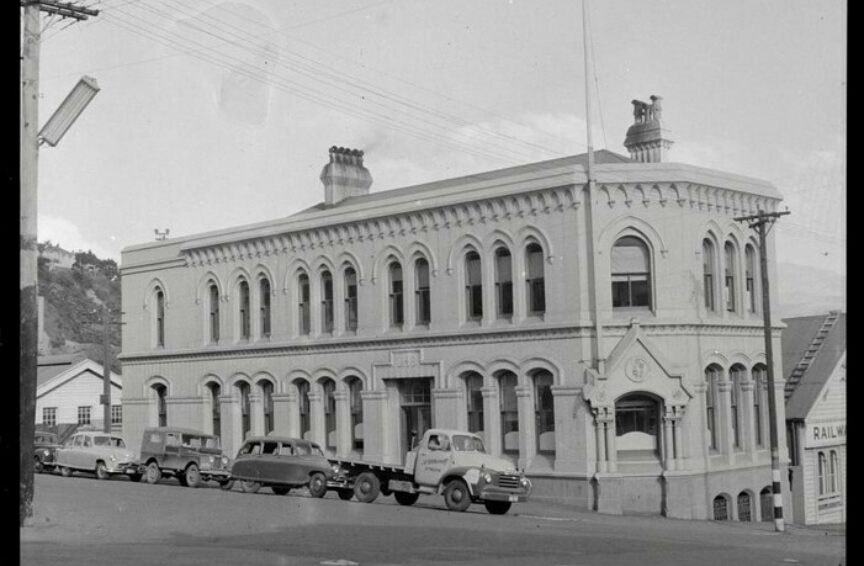PO Box 95
Lyttelton 8841
Te Ūaka recognises Te Hapū o Ngāti Wheke as Mana Whenua and Mana Moana for Te Whakaraupō / Lyttelton Harbour.
The Lyttelton Timeball Station – Part Two
Having highlighted the purpose and function of the Lyttelton Timeball Station last week, today we focus on the original building and some of the people who called it home.
The 1876 Timeball Station was designed by Provincial Architect Thomas Cane; his charming watercolour painting captures the castle-like quality of the architecture, with gothic windows and Oamaru stone quoins, corbels and parapets.
The building was constructed of scoria from the Sumner Road quarries by William Brassington and John Kennington, with labour provided by prisoners from the Lyttelton Gaol. The tower's beautiful spiral staircase of Cass Peak bluestone was much admired, not least because the column and cantilevered step were cut in one piece; a rare example of this methodology. Brassington’s fine carved shields which flanked the original entry were also worthy of note.
The interior of the building featured kauri and oregon ceilings and baltic pine floors and doors – mostly imported wood as Banks Peninsula had little suitable timber at that time. With windows opening inwards, a flat lead roof and the porous scoria body of the structure, issues of excessive heat, cold and water ingress soon became apparent. During 1877-1878, under the watchful eye of architect Frederick Strouts, the building was weatherproofed with a stucco cement coating and additional stone walls built to cut the wind on the exposed site.
The first to use the building were Alexander Joyce, telegraphist and timeball keeper from 1876-1914, in residence with his wife and two sons, John Toomey, flag signalman from 1879-1892, and Alfred Button, a Crimean war veteran and flag signalman and timeball keeper from 1892-1905.
By 1911, John Porteous had been in residence as signalman (and from 1914-1932 also holding the role of timeball keeper) since 1905, along with his wife and seven children. For this family the damp and cramped conditions with no bathroom had become intolerable. Porteous successfully petitioned the Harbour Board such that in 1912 Harbour Board engineer Cyrus Williams designed a two storey extension with more living space. This was built of stucco covered brick and Oamaru stone detailing to tie in with the original building.
Later residents included Jack and Phyllis Burns and their children from 1932-1941, the Army during WW2, the Collins family from 1943-1958, and Owen Berry from 1959-1967.
By the late 1960’s the building had fallen into significant disrepair and the Harbour Board was no longer interested in its expensive upkeep. A group of local enthusiasts set up the Lyttelton Maritime Association; led by Harbour master Captain Roy Champion, they began the huge task of restoring the building and mechanism. However, by 1973, with the Association unable to meet increasing repair costs, the building and site were gifted to the Historic Places Trust. This enabled a major restoration, with the guidance of architect AP Harper and stonemason James Cormie, to take place during 1975-1976. For some years the building again housed private tenants.
In the early 21st century, the Lyttelton Timeball Station was one of only a handful left operational world-wide, and held Category 1 Historic Place status. Another major phase of restoration in the early 2000s took place under the auspices of the Historic Places Trust, with many expert tradespeople involved and Goldfield Stone leading the repair of the stonework. The building interior was dressed in Victorian style and was open to the public, with flags again flown from the flagpole and a daily time ball drop. In this phase, the site was a popular venue for school visits, tourism groups, historical and music events, and weddings.
Tragically, the earthquakes of 2010 and 2011 dealt the building several devastating blows. The damage necessitated a careful deconstruction after the building all but collapsed in an aftershock on 13 June 2011. However, due to the generosity of several major donors, in 2017-2018 the current tower was built by Hawkins, with stonework completed by Bosworth and Barthal Stone Restoration and local company Stark Engineering rebuilding the now automated mechanism.
You can once again see the tower on the skyline and visit the site with the best view in town – watch out for the ball drop at 1 pm – and read about the Heritage NZ led construction of the current building. The design of Te Ūaka The Lyttelton Museum proposed new building features a window which encompasses the view of this important Lyttelton landmark.

